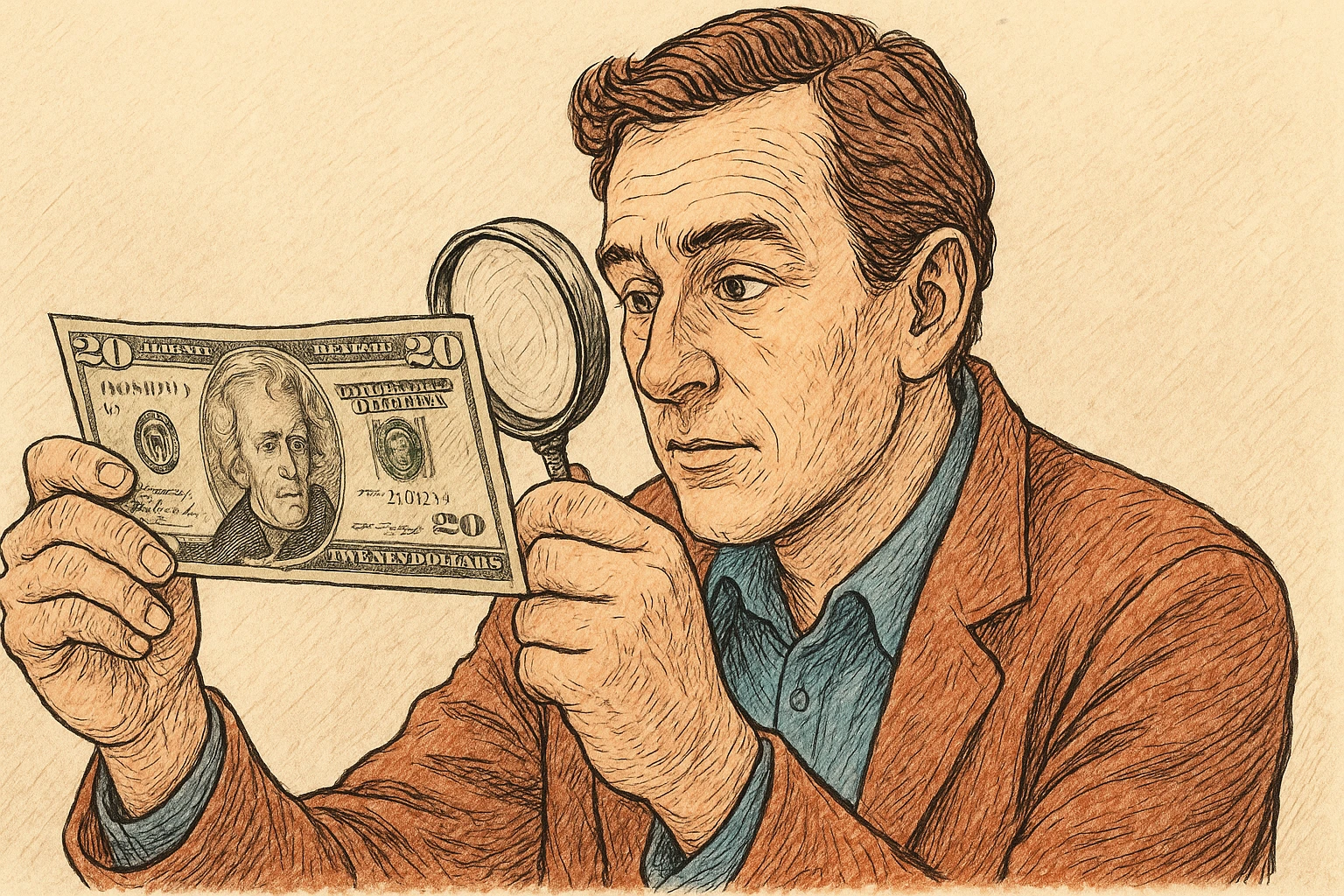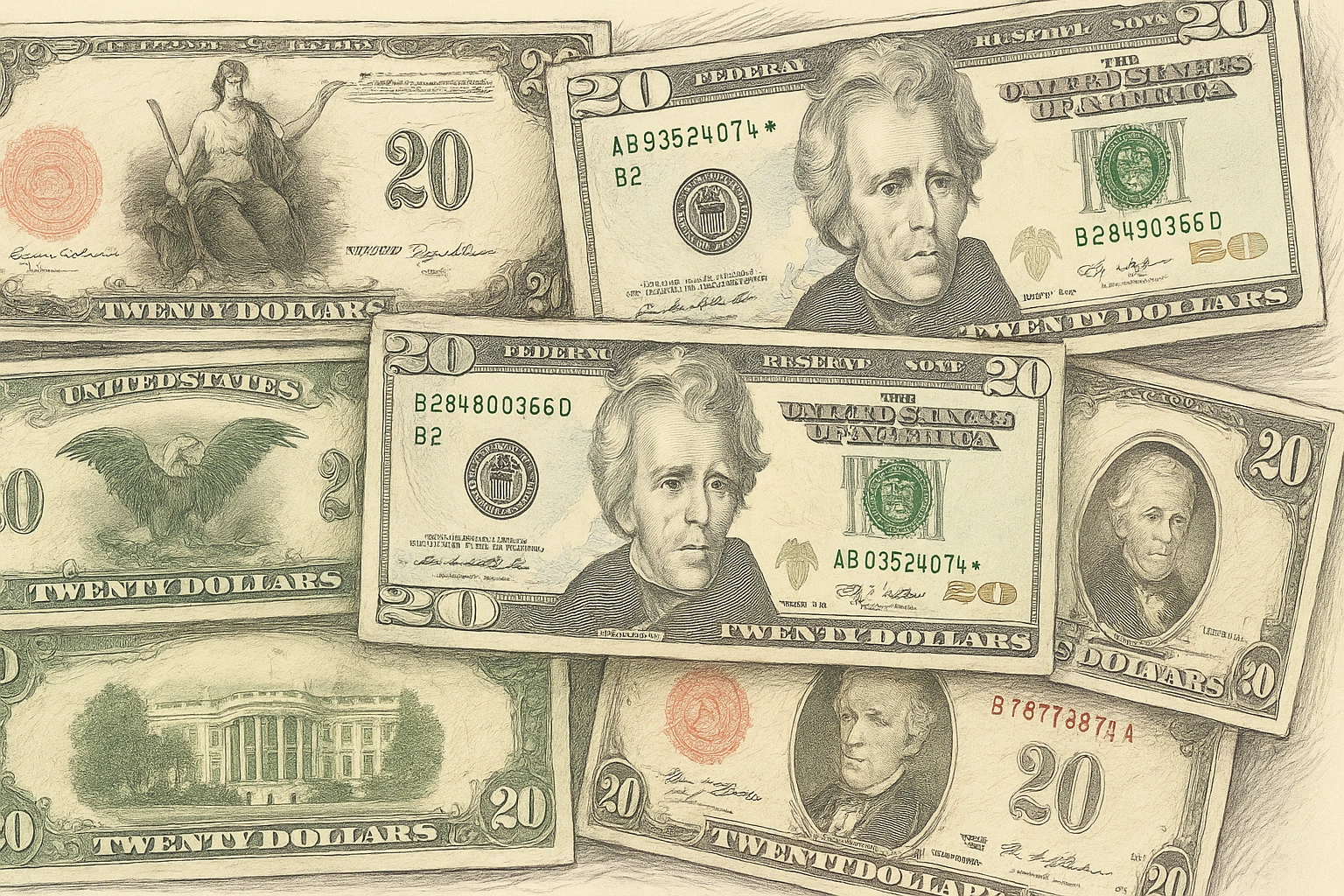When you reach for a $20 bill to pay for lunch or tuck it into a birthday card, you probably don’t give much thought to its history. But beneath the familiar green ink and Andrew Jackson’s solemn portrait lies a legacy stretching over 160 years.
The journey of who is on the 20 dollar bill is not only a tale of evolving design and anti-counterfeit technologies—it’s also one of political irony, economic transformation, and surprising collectible value.

A Brief Timeline of the $20 Bill
Let’s start with where it all began:
| Year | Milestone |
| 1861 | First $20 “Demand Note” issued during the Civil War |
| 1863–1907 | Series of Legal Tender Notes, Gold Certificates, Silver Certificates released |
| 1914 | Federal Reserve Notes introduced |
| 1928 | Shift from large-size to small-size notes; Andrew Jackson appears |
| 2003–Present | Modern security redesigns with color-shifting ink, watermarks, and threads |
From its first printing in 1861, the $20 bill served not only as a tool of commerce but also as a reflection of the country’s economic and political climate. That inaugural Demand Note, featuring an allegorical female figure, was issued as the Union scrambled for funds during the Civil War. It set the stage for a long series of evolving note types, each uniquely tied to its historical moment.
Allegory, Gold, and Changing Faces
Throughout the 19th and early 20th centuries, the $20 bill took on various forms. Some bore mythological symbols like the Goddess of Liberty; others celebrated industrial progress or agricultural bounty. The U.S. Treasury experimented with Gold Certificates—backed by actual gold held in reserve—and Silver Certificates, linked to silver bullion.
Each redesign was not just aesthetic but functional. New notes came with different sizes, paper stock, serial number placements, and colored seals, all aimed at improving security or keeping pace with economic needs.
Why Andrew Jackson?
It wasn’t until 1928 that the familiar visage of President Andrew Jackson appeared on the bill. That year, the U.S. adopted a smaller format for all paper currency—a cost-saving move amid rising production demands. Jackson, a populist president known for his distrust of centralized banking and paper money, was an ironic choice. He had vehemently opposed the national bank and the very idea of fiat currency during his administration.
Still, his rugged frontier image aligned with American ideals of independence and resilience. The White House was chosen for the reverse side, symbolizing executive power and national unity.
Modern Designs and Anti-Counterfeit Features
As counterfeiting threats increased, the $20 bill saw multiple overhauls:
- 1990s: Security threads and microprinting introduced
- 2003: First major color redesign added subtle peach and blue tones, watermarks, and a security ribbon
- Ongoing: Future plans may replace Jackson with Harriet Tubman, highlighting a cultural shift toward broader representation in U.S. currency
These changes weren’t just cosmetic—they were crucial to preserving the integrity of U.S. currency in the digital age, when high-resolution printers and scanners gave counterfeiters an edge.
Fun Fact: Every $20 Bill Ever Issued Is Still Legal Tender
Yes, even that faded 1861 Demand Note tucked in a private collection or museum vault is technically worth $20 at face value. But of course, its actual market value is much higher—potentially tens of thousands of dollars—thanks to rarity, condition, and historical relevance.
What Makes a $20 Bill Collectible?
To determine whether a $20 bill is collectible, consider the following characteristics:
1. Age of the Bill
- Pre-1914 notes (especially large-sized notes like Gold Certificates or Legal Tender Notes) are among the most coveted in numismatics.
- Even 1928–1934 small-sized bills are desirable, particularly in high grades or rare signature combinations.
2. Condition (Grade)
- Bills in “uncirculated” or “gem” condition—those without folds, stains, or wear—command the highest prices.
- A well-preserved note can be worth 10x to 100x more than the same note in average condition.
3. Rarity and Type
- Some notes, especially those with unique signature pairings, short production runs, or special series designations, are extremely rare.
- These are tracked by Friedberg numbers, a cataloging system used by currency collectors.
4. Serial Number
Special or unusual serial numbers make a bill more desirable:
| Serial Type | Example | Why It’s Valuable |
| Low Serial Numbers | 00000001 – 00000999 | Early print runs are collectible |
| Star Notes | AB123456* | Replacements for damaged bills; rarer |
| Palindromes | 12344321 | Symmetrical, highly sought after |
| Repeater/Trinary Notes | 12121212 / 11223344 | Eye-catching, limited occurrences |
| Solid Digits | 77777777 | Extremely rare and in high demand |
5. Historical or Transitional Context
- Certain $20 bills mark significant shifts in design or policy—like the 1928 series, which introduced small-size Federal Reserve Notes, or emergency issues like Hawaii or North Africa notes during WWII (more common in $1–$10 denominations, but similar patterns apply to $20s).
- Notes tied to major events or issued during transitional periods are often hot items for collectors.

Notable Examples of Valuable $20 Bills
Here are a few standout examples of collectible $20s and why they’ve sold for so much at auction:
| Bill Type / Year | Auction Value | Why It’s Valuable |
| 1861 Demand Note (Fr. 11) | $72,000 (2020) | First-ever $20 bill, Civil War issue, ultra-rare in any condition |
| 1869 Legal Tender Note (Fr. 127) | $50,400 (2024) | Early issue with vivid “Rainbow” color design and excellent grade |
| 1863 Legal Tender (Fr. 126b) | $19,200 (2023) | High grade and extremely low survival rate |
| 1928 Small Size FRN | up to $21,600+ | Rare serial combinations or signature pairings in pristine shape |
Note: Even modern $20 star notes or those with quirky serial numbers can be worth several hundred dollars, especially if they’re in uncirculated condition.
Quick Tips to Identify a Potentially Valuable $20 Bill
If you’re curious whether your $20 bill might be collectible, here’s a simple checklist:
- Check the Series Year – Look at the small print near the bottom-left of Jackson’s portrait.
- Inspect the Serial Number – Look for repeating patterns, symmetry, or the elusive star.
- Feel the Paper – Older notes have distinct paper textures, and genuine U.S. currency has a specific cotton-linen blend.
- Check for Unusual Features – Off-center printing, ink smears, or misalignment might signal an error note.
- Get it Appraised – A certified paper money dealer or professional grading service (like PMG or PCGS) can confirm authenticity and value.
Boost Your Collecting Game with the Coin ID Scanner App
Although the Coin ID Scanner app is designed for coins, it offers powerful capabilities that can support your broader collecting efforts—including currency collecting. Here’s how this innovative app adds value to both beginners and experts alike:
| Feature | Benefit |
| Photo-Based Coin Identification | Instantly recognize coins by snapping or uploading a photo; ideal for sorting unknown or inherited collections |
| Coin Card Details | Get full data on country, year, mintmark, metal composition, edge, weight, and price range |
| Digital Collection Manager | Organize and track your physical collection with high-res images and detailed notes |
| Extensive Global Database | Access records for over 187,000 coins from around the world |
| Smart Filters (Premium) | Narrow your search by era, rarity, metal type, or country |
| AI Coin Helper | Get expert-backed insights and valuation suggestions at your fingertips |
Even if your main focus is paper currency, these features allow you to cross-reference coin data, verify dates and minting trends, and build a broader understanding of monetary history.
Pro Tip: Collectors who build both paper and coin collections often spot crossover patterns—like matching serial numbers on bills and coin release years. Keeping your entire collection digitized helps reveal connections that physical inspection might miss.
Final Thoughts: Is Your $20 Bill Just Paper—Or a Hidden Gem?
The $20 bill is more than just the workhorse of wallets—it’s a historical artifact, a collector’s opportunity, and sometimes, an unexpected jackpot. From the Civil War–era Demand Notes to the colorized, micro-printed versions in circulation today, each bill tells a story of America’s evolving economy, politics, and culture.
While not every $20 bill will pay off big, understanding the details—serial numbers, issue dates, conditions, and design types—can unlock value far beyond its face amount. And with apps like Coin ID Scanner, building a reliable, digitized collection has never been easier.
What You Can Do Next:
- Check your wallet, drawers, and old birthday cards for vintage $20s.
- Scan serial numbers for patterns or stars.
- Protect rare finds in sleeves or currency holders.
- Start a digital log with images and dates.
- Use tools like Coin ID Scanner to document coins that accompany your currency collection.
The world of collectible currency is deep, rewarding, and constantly evolving. Whether you’re chasing the next rare banknote or digitizing a coin trove, you’re part of a tradition that values curiosity, detail, and history—right down to the smallest print on a well-worn twenty.
